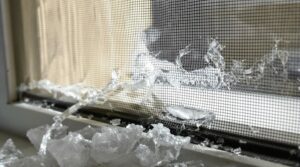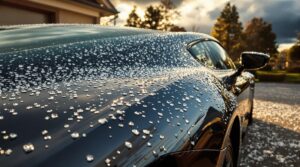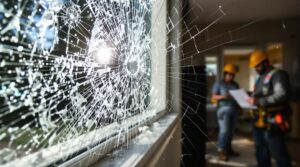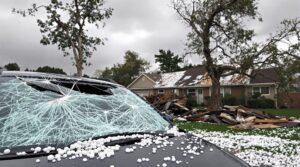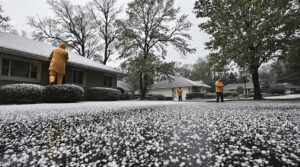Insurance companies typically pay around $12,000 for residential hail damage claims and $4,000 for vehicle-related hail damage. These averages vary considerably based on factors like geographic location, property age, and damage extent. State Farm processed $3.5 billion in total hail claims during 2022, with Texas leading at $510 million. Multiple variables influence final settlement amounts, including policy type, documentation quality, and adjuster evaluations. Understanding these factors can lead to ideal claim outcomes.
Key Takeaways
- Homeowners typically receive around $12,000 for hail damage insurance claims on their properties.
- Vehicle owners receive an average payout of approximately $4,000 for auto-related hail damage claims.
- State Farm processed $2.9 billion in homeowner hail claims and $600 million in auto claims during 2022.
- Texas led hail damage claims with $510 million in 2022, showing regional variations in payout amounts.
- Final settlement amounts depend on factors like damage extent, property age, local repair costs, and policy type.
Understanding Average Hail Damage Insurance Payouts
When homeowners and vehicle owners experience hail damage, understanding typical insurance payouts becomes essential for financial planning. Current average payout trends indicate that homeowners typically receive around $12,000 for hail damage claims, while vehicle owners receive approximately $4,000 for auto-related damage.
Hail damage statistics from 2022 reveal significant financial impact across the insurance industry. State Farm alone processed $3.5 billion in hail claims, marking a $1 billion increase from the previous year. Of this total, homeowner's insurance claims accounted for $2.9 billion, while auto insurance claims reached $600 million.
Regional variations exist, with Texas leading in claim volumes at $710 million in 2021. These figures demonstrate the substantial financial implications of hail damage and underscore the importance of adequate insurance coverage.
Actual payouts vary based on factors including property condition, material types, and specific policy terms, with replacement cost policies potentially offering more extensive coverage than actual cash value options. Working with a public adjuster during the claims process can help maximize compensation for hail-related damages.
Factors That Determine Your Hail Damage Claim Amount
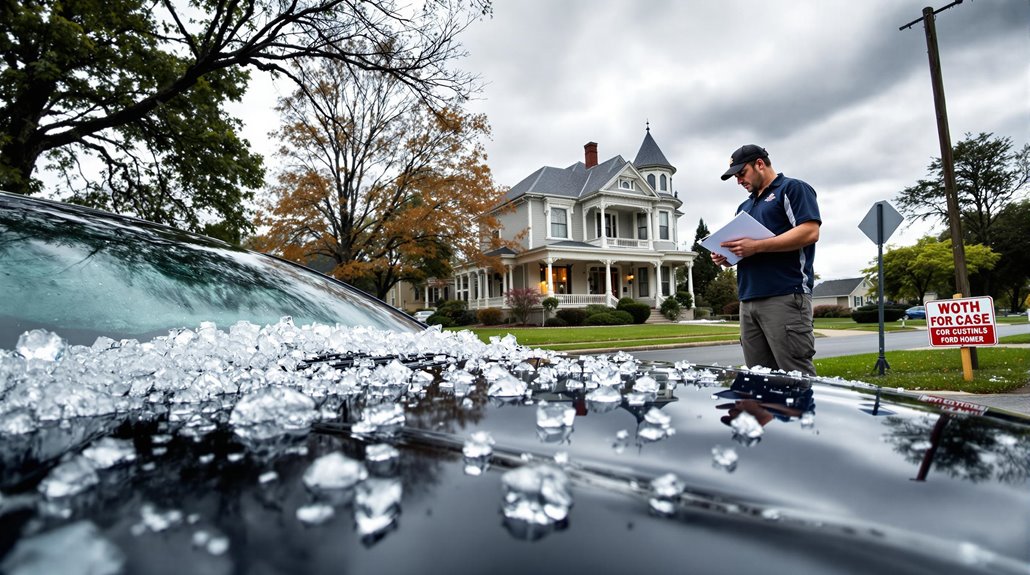
Several key variables influence the final amount an insurance company pays for hail damage claims. During hail damage assessment, adjusters evaluate the extent and type of damage, considering factors like hailstone size and whether the damage is cosmetic or structural.
The property's age and condition greatly affect depreciation calculations, while local repair costs vary by geographic location.
Insurance policy evaluation plays an essential role in determining payouts. The type of coverage (comprehensive vs. liability), policy terms (ACV vs. RCV), and deductible amounts directly impact claim settlements.
Policy limits and specific exclusions can also restrict potential payouts. Additionally, the timing and quality of damage documentation, along with the thoroughness of professional inspections, influence final settlements.
Regional factors, including the frequency of hailstorms, local construction costs, and insurance regulations, further shape claim amounts. Properties in high-risk areas may experience different payout structures due to these location-specific considerations.
Public insurance adjusters can help homeowners maximize their claim settlements by identifying discrepancies in underpaid settlements.
Types of Insurance Coverage That Protect Against Hail
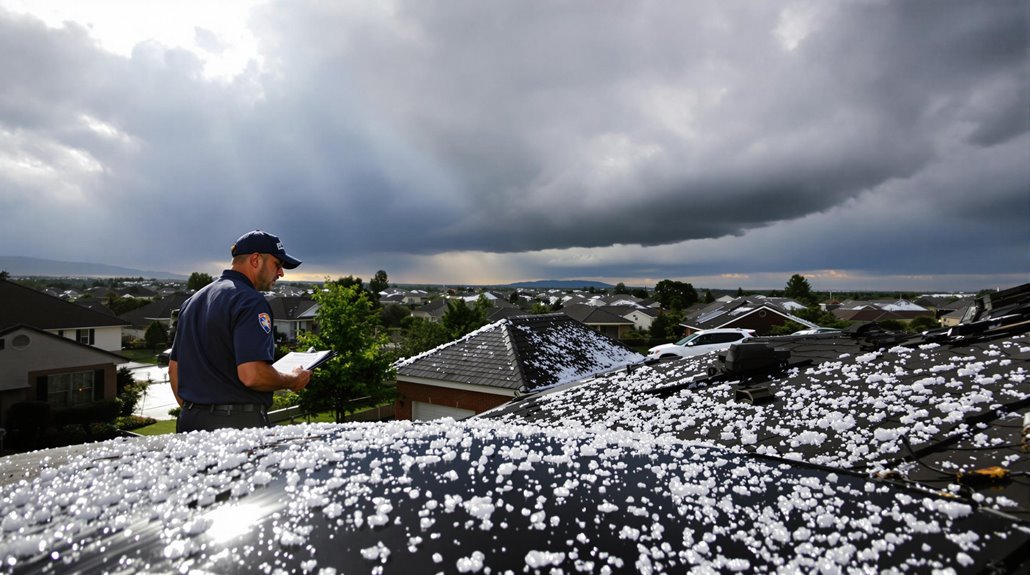
Insurance providers offer multiple coverage types that protect against hail-related property damage. When comparing insurance policy options, extensive replacement cost value (RCV) insurance emerges as a primary form of hail damage prevention, covering structures, roofs, and contents against severe weather events. This coverage type, while optional in most states, proves particularly valuable in hail-prone regions.
Homeowners insurance typically includes dwelling coverage that addresses hail damage to roofs, requiring documented proof of damage from hail measuring 1 inch or larger in diameter.
For vehicles, extensive auto coverage specifically protects against hail damage, though this remains optional unless required by lenders. Despite the average hail damage claim reaching approximately $12,000, only 30% of homeowners fully understand their policy coverage.
Standard policies generally incorporate hail protection within their dwelling coverage, supporting repair or replacement costs subject to specified deductibles and coverage limits.
Public insurance adjusters can help maximize settlement amounts and assist with documenting hail damage claims for optimal compensation.
Steps to Maximize Your Hail Damage Insurance Settlement
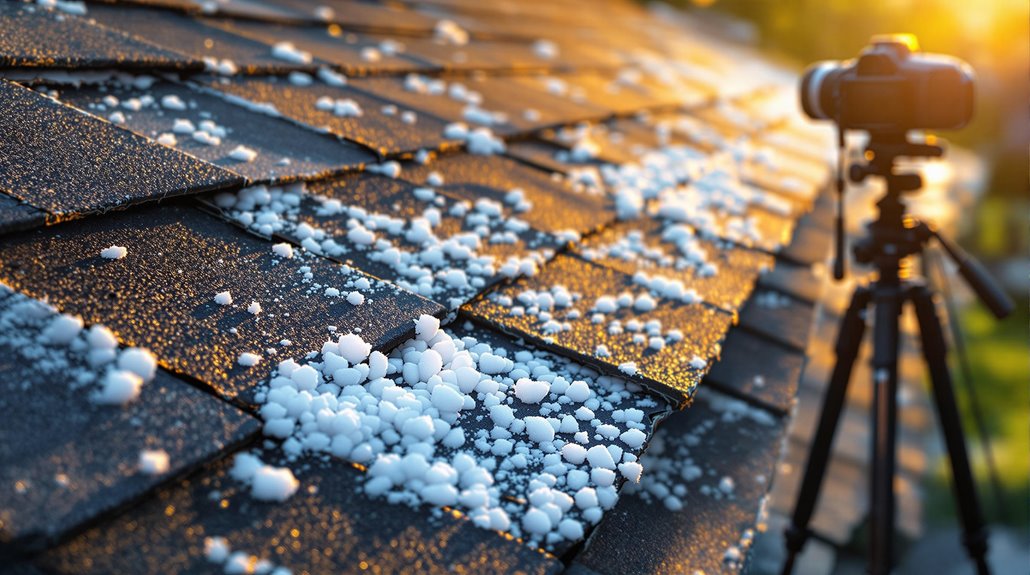
Thorough documentation of hail damage through photographs, videos, and written records serves as vital evidence when filing an insurance claim.
Insurance companies require detailed proof of losses to process claims effectively, making it essential to capture extensive documentation immediately after the damaging event.
Understanding policy limits and coverage specifications enables policyholders to pursue appropriate compensation within the bounds of their insurance agreement.
Effective communication between the homeowner, insurance adjuster, and roofing contractor helps ensure a smoother claims process and fair settlement.
Document Everything Carefully
Proper documentation serves as the foundation for maximizing an insurance settlement for hail damage. The documentation importance cannot be overstated, as it provides essential evidence for the claim's validity.
Extensive photographic evidence should include multiple angles, timestamps, and size references to establish damage scope.
A thorough documentation process involves collecting detailed repair estimates from licensed contractors, maintaining records of temporary fixes, and creating an initial damage report.
All visual evidence, professional inspection findings, and repair receipts should be systematically organized. When submitting documentation to the insurance company, claimants must guarantee accuracy and completeness, including weather reports that correlate with the hail event.
Understanding policy coverage and maintaining communication records with insurance representatives further strengthens the claim's documentation.
Public adjusters can provide expert assistance in documenting and maximizing settlement amounts from insurance claims while advocating exclusively for the homeowner.
Know Your Policy Limits
Before filing a hail damage claim, homeowners must thoroughly understand their policy limits and coverage specifications to maximize potential settlements. Insurance policies typically include specific coverage limits, deductible implications, and policy exclusions that directly impact claim payouts.
Understanding the distinction between Actual Cash Value (ACV) and Replacement Cost Value (RCV) is vital, as this determines whether depreciation will be factored into the settlement amount.
Regular policy reviews help identify coverage gaps and guarantee adequate protection for hail-related damages. Homeowners should examine their dwelling coverage limits, verify specific perils coverage, and understand their deductible obligations.
This knowledge enables informed decisions during the claims process and helps prevent unexpected financial burdens when negotiating settlements with insurance providers.
Common Insurance Company Policies for Hail Claims

Most insurance companies maintain standardized procedures for processing hail damage claims, which typically involve specific timeframes, documentation requirements, and payment protocols. The claim filing process generally requires policyholders to submit their claims within one year of the incident, though some states allow longer periods.
During damage assessment, an assigned adjuster inspects the property and determines coverage eligibility.
Insurance providers follow established procedures for repair and payment disbursement:
- Initial payment based on Actual Cash Value (ACV) of damaged property
- Final payment reflecting Replacement Cost Value (RCV) upon completion of repairs
- Reimbursement for temporary protective measures, such as tarp installation
While the average hail damage payout reaches approximately $12,000 for residential properties, premium impacts remain minimal for single claims.
Most policies include hail coverage in their standard protection, though rates may vary based on geographical risk factors. Policyholders should review their specific policy terms to understand claim timeframes and coverage limitations.
Regional Differences in Hail Damage Coverage
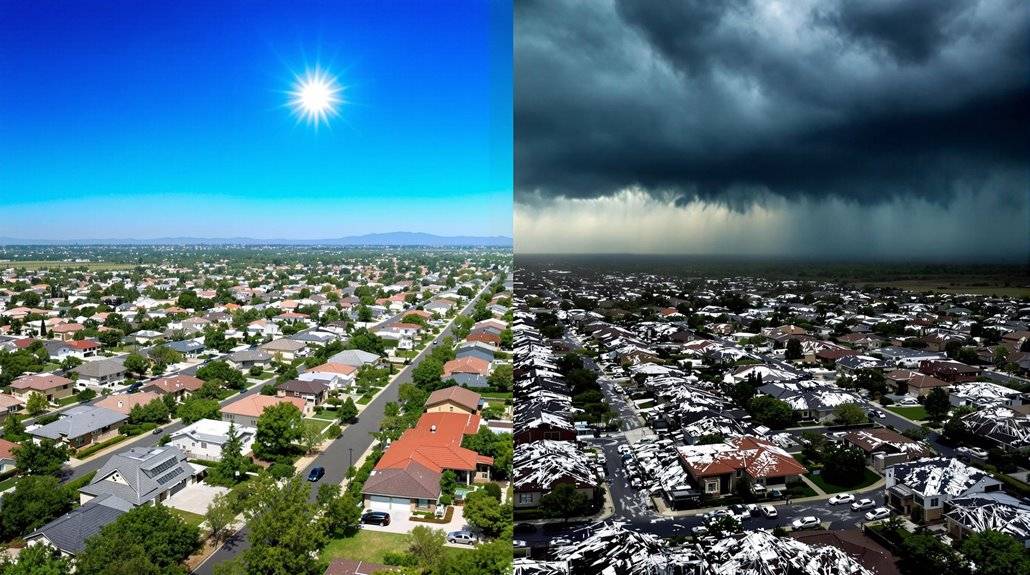
Due to varying levels of hail risk across the United States, insurance coverage for hail damage exhibits significant regional differences regarding premiums, deductibles, and availability. State comparisons reveal substantial variations in claims and coverage approaches, particularly in high-risk areas. Texas reported $510 million in hail claims during 2022, while Colorado experienced a 52% surge in average premiums, with 76% of carriers reducing coverage availability.
| State | Risk Level | Insurance Impact |
|---|---|---|
| Texas | Very High | High claims, increased deductibles |
| Colorado | High | Premium surges, reduced coverage |
| Minnesota | High | Frequent severe claims |
| California | Low | Limited hail coverage |
| Florida | Low | Focus on other hazards |
Regional risk assessment has become increasingly sophisticated, with insurers utilizing data-driven approaches and granular analysis to determine coverage terms. The "Hail Alley" states, including Texas, New Mexico, and Colorado, typically require specialized coverage options due to their elevated risk profiles, while lower-risk regions may incorporate hail coverage within standard policies.
Impact of Vehicle Type and Age on Hail Damage Payouts

The correlation between vehicle characteristics and insurance payouts for hail damage reveals a complex interplay of factors. Vehicle age greatly influences settlement amounts through vehicle depreciation, with newer automobiles typically receiving higher compensation due to their greater market value and repair costs.
Similarly, vehicle type plays a vital role in determining payout amounts, with luxury vehicles commanding higher settlements due to specialized repair requirements and premium parts costs.
Key determinants of hail damage payouts include:
- Age-related depreciation – Older vehicles receive lower payouts due to diminished value, while newer models warrant higher settlements.
- Vehicle category impact – Premium and luxury vehicles typically receive larger payouts due to specialized repair requirements.
- Construction complexity – High-end vehicles with sophisticated materials and design elements require more expensive repairs.
These factors work in conjunction with policy specifics and damage extent to determine final payout amounts, creating a standardized yet flexible framework for insurance settlements.
Strategies to Navigate the Hail Damage Claims Process
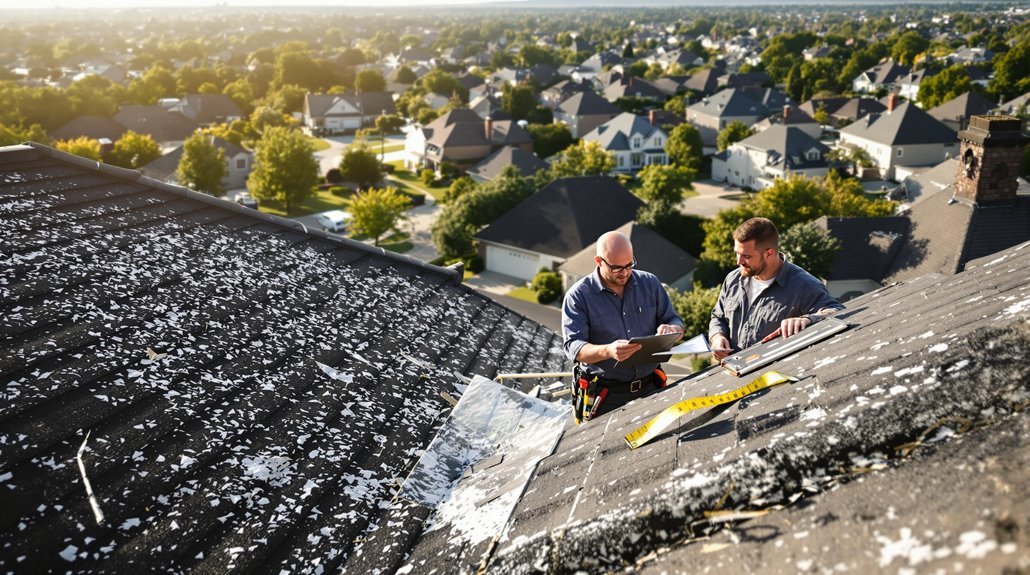
Successfully maneuvering the hail damage claims process requires a systematic approach focused on thorough documentation and strategic engagement with insurance providers. The initial damage assessment should include extensive photographic evidence, precise measurements of hailstones, and detailed documentation of all affected areas.
Critical steps in the claim process include immediately reporting the incident to the insurance company, submitting necessary documentation through official channels, and coordinating inspections with insurance adjusters.
Having a local roofer present during the adjuster's inspection can provide additional technical expertise and support for the claim. Understanding policy coverage, deductibles, and potential reasons for claim denials enables more effective negotiation with adjusters.
Maintaining records of temporary repairs and collecting multiple contractor estimates strengthens the position during settlement discussions. If complications arise, engaging a public insurance adjuster can help guarantee fair compensation, particularly in cases involving complex damage assessment or disputed claims.
The Benefits Of Consulting A Public Adjuster

Public adjusters offer specialized expertise in managing complex hail damage insurance claims through their thorough understanding of policy coverage and claims procedures.
Their objective assessment methods and professional documentation of damage help establish accurate valuations while removing emotional bias from the process.
Studies indicate that claims handled by public adjusters often result in notably higher settlements, with professional representation streamlining the entire claims process from initial filing to final resolution.
Expertise In Insurance Claims
When dealing with complex hail damage insurance claims, consulting a public adjuster can greatly improve the likelihood of receiving fair compensation.
These licensed professionals possess extensive knowledge in policy interpretation and claims negotiation, ensuring policyholders receive maximum settlements for their damages. Their expertise allows them to navigate complex insurance policies and identify all covered losses.
Public adjusters provide critical advantages through:
- Specialized knowledge of insurance policies and coverage exclusions
- Professional documentation and valuation of property damage
- Expert negotiation skills with insurance carriers
Their objective approach removes emotional elements from the claims process while ensuring thorough documentation of damages.
As advocates working exclusively for policyholders, public adjusters handle all aspects of the claim, from initial assessment through final settlement, applying their technical expertise to secure ideal compensation.
Objective Damage Assessment
One of the primary advantages of engaging a public adjuster lies in their ability to conduct objective damage assessments following hail events. These professionals perform extensive damage evaluations that identify both obvious and subtle forms of property deterioration, ensuring no damages are overlooked during the claims process.
Public adjusters utilize their expertise to conduct thorough loss assessments that establish accurate repair cost estimates. Their methodical approach includes detailed documentation of all damages, providing a solid foundation for insurance claims.
This systematic evaluation process encompasses examining structural components, roofing materials, and other vulnerable areas that may have sustained hail impact. The resulting assessment serves as essential documentation when determining the full extent of damages and establishing the appropriate compensation amount during insurance settlement negotiations.
Streamlined Claim Process
Engaging a public adjuster greatly streamlines the insurance claim process for hail damage victims.
These licensed professionals enhance claim efficiency through expert navigation of complex insurance procedures while providing thorough policyholder support. Their involvement guarantees proper documentation, timely communication, and professional representation throughout the settlement process.
Key advantages of public adjuster assistance include:
- Expedited claim resolution through professional management of documentation and insurance company communications
- Reduced policyholder stress by handling all aspects of the claim process, allowing property owners to focus on recovery
- Expert advocacy during negotiations, leveraging industry knowledge to secure fair settlements
Public adjusters serve as dedicated representatives who work exclusively for the policyholder's interests, utilizing their expertise to navigate insurance requirements and optimize claim outcomes.
Higher Claim Payouts & Settlements
The financial benefits of consulting a public adjuster for hail damage claims extend beyond streamlined processes to considerably higher settlement amounts.
Public adjusters consistently achieve superior payouts through expert claim negotiation techniques and extensive damage assessment protocols. These licensed professionals leverage their specialized knowledge of insurance laws and industry practices to maximize settlements.
Their thorough understanding of policy coverage, combined with meticulous documentation and evidence compilation, strengthens the policyholder's position during negotiations. Public adjusters counter insurance company strategies effectively, utilizing their expertise to identify all compensable damages.
Operating on a contingency fee basis, public adjusters are incentivized to secure ideal settlements. Their access to professional resources, including contractors and appraisers, further enhances the claim's value through detailed damage verification and accurate cost estimation.
About The Public Claims Adjusters Network (PCAN)
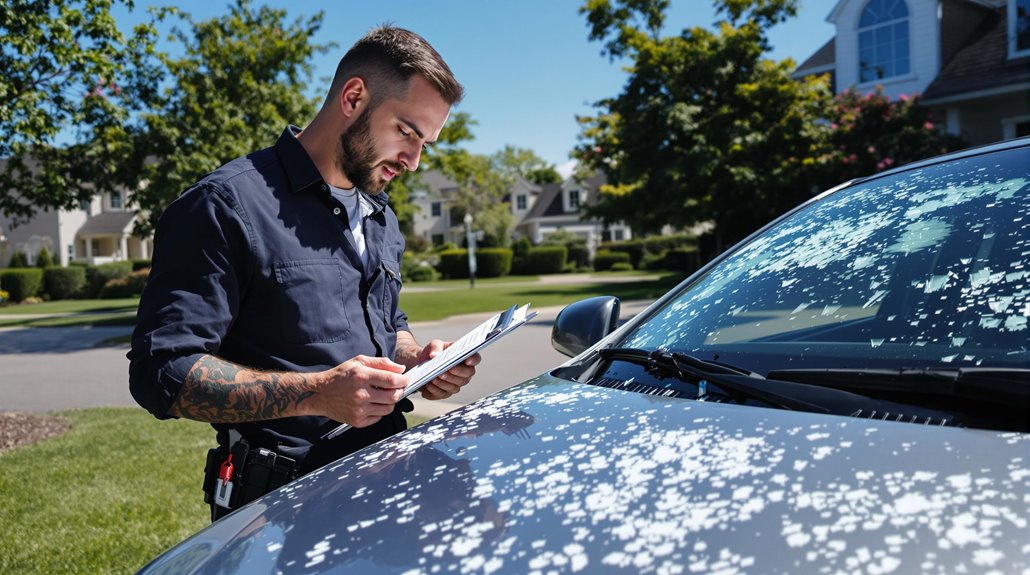
Networks of public claims adjusters provide essential support services for policyholders traversing complex insurance claims processes. Organizations like WorldClaim and NICA offer thorough public adjuster roles focused on professional claims handling, operating across all 50 states and internationally.
These licensed professionals work independently to advocate for policyholder interests, leveraging their expertise in damage assessment and policy interpretation.
Key services provided by the network include:
- Expert damage evaluation and documentation for accurate claim amounts
- Complete management of claim filing and communication processes
- Professional negotiation with insurance companies to secure ideal settlements
The Public Claims Adjusters Network maintains high operational standards through professional licensing requirements and extensive industry experience.
Unlike company-employed adjusters, network members work exclusively for policyholders, ensuring dedicated advocacy throughout the claims process. This independence, combined with their technical expertise, enables public adjusters to navigate complex claims while securing favorable outcomes for their clients.
Frequently Asked Questions
Will Insurance Cover Hail Damage if My Car Was Parked Outside?
Insurance typically covers hail damage for cars parked outside, subject to coverage limitations and damage assessment, provided the policy includes extensive coverage. Location of the vehicle doesn't affect claim eligibility.
How Long Do I Have to File a Hail Damage Claim?
Insurance claim deadlines for hail damage typically allow one year from the date of occurrence. The filing process should begin immediately to guarantee compliance with policy requirements and documentation standards.
Can I Choose Any Repair Shop for Hail Damage Repairs?
Policyholders typically have freedom to select their preferred repair shop for hail damage repairs, subject to insurance policy limits. Most insurers allow independent choices while some maintain preferred provider networks.
Does a Hail Damage Claim Affect My Insurance Score?
Filing a hail damage claim can impact insurance scores, potentially leading to increased insurance premiums. While considered an act of nature, multiple claims within a short period affect the claim process negatively.
Will Insurance Cover Rental Car Costs During Hail Damage Repairs?
Thorough insurance policies typically include rental reimbursement coverage for temporary transportation options during hail damage repairs, though specific coverage limits and terms vary among different insurance providers.
References
- https://www.consumershield.com/articles/average-insurance-payout-for-hail-damage-car
- https://nycmidtownlimo.com/understanding-the-average-insurance-payout-for-hail-damage-to-your-car/
- https://stormwisehailrepair.com/how-much-does-insurance-cover-hail-damage/
- https://www.omarochoalaw.com/blog/how-much-does-insurance-pay-for-hail-damage
- https://www.cbtrial.com/understanding-hail-damage-insurance/
- https://econosurance.com/property-insurance/how-much-does-insurance-pay-for-hail-damage
- https://www.exterioralliance.com/roof-hail-damage/average-insurance-payout-for-hail-damage-roof/
- https://www.southernroofingco.com/hail-no-demystifying-the-average-roof-damage-insurance-payout/
- https://roof-troopers.com/blog/average-insurance-payout-for-hail-damage-roof/
- https://www.insuranceclaimrecoverysupport.com/hail-damage-covered-by-insurance/

